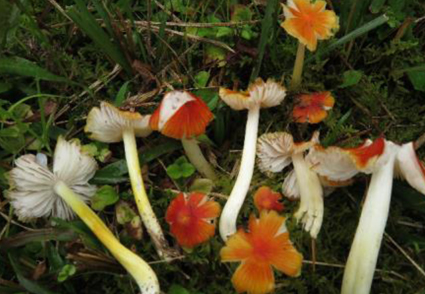Abstract
Hygrocybe rimosa, a new poisonous species belonging to subg. Hygrocybe, is described from southern China with both phylogenetic and morphological data. This species can cause nausea, vomiting, and abdominal pain. Morphologically, it is characterized by its orange to red and fibrillose pileus, irregularly split pileus margin, free, broad to ventricose, white lamellae, and subglobose to oblong basidiospores measuring (7)7.5–11 ×5–8(8.5) μm. Phylogenetically, analyses based on the internal transcribed spacer (ITS) region and the nuclear ribosomal RNA large subunit (LSU) indicate that H. rimosa is a member of subg. Hygrocybe. Ecologically, the new taxon usually grows in subtropical grasslands.
References
<p>Bon, M. (1976) Novetates. <em>Docums Mycol</em> 24 (6): 41–46. https://doi.org/10.1177/216507997602400417</p>
<p>Candusso, M. (1997) <em>Fungi Europaei 6. Hygrophorus s.l.</em> Libreria Basso, Alassio, 784 pp.</p>
<p>Chen, Z.H., Yang, Z.L., Bau, T. & Li, T.H. (2016) <em>Poisonous mushrooms: recognition and poisoning treatment</em>. Science Press, Beijing, 308 pp.</p>
<p>Cubeta, M.A., Echandi, E., Abenerthy, T. & Vilgalys, R. (1991) Characterization of anastomosis groups of binucleate rhizoctonia species using restriction analysis of an amplified ribosomal RNA gene. <em>Phytopathology </em>81 (11): 1395–1400.</p>
<p>Fayod, M.V. (1889) Prodrome d’une histoire naturelle des Agaricinés. <em>Annales des Sciences Naturelles Botanique</em> 7 (9): 181–411. https://doi.org/10.1094/Phyto-81-1395</p>
<p>Gray, S.F. (1821) <em>Natural arrangement of British Plants, according to their relation to each other</em>. Baldwin, Craddock, and Joy, London, 824 pp. https://doi.org/10.5962/bhl.title.43804</p>
<p>He, Z.M. & Yang, Z.L. (2021) A new clitocyboid genus <em>Spodocybe</em> and a new subfamily Cuphophylloideae in the family Hygrophoraceae (Agaricales). <em>Mycokeys</em> 79: 129–148. https://doi.org/10.3897/mycokeys.79.66302</p>
<p>Hongo, T. (1982) Hygrophoraceae of Japan. <em>Memoirs of the Faculty of Liberal Arts of the Shiga University</em> 32: 85–92.</p>
<p>Kalyaanamoorthy, S., Minh, B.Q., Wong, T.K.F., von Haeseler, A. & Jermiin, L.S. (2017) ModelFinder: fast model selection for accurate phylogenetic estimates. <em>Nature Methods </em>14: 587–589. https://doi.org/10.1038/nmeth.4285</p>
<p>Karsten, P.A. (1879) Rysslands, Finlands och den Skandinaviska halföns Hattsvampar. Förra Delen: Skifsvampar. Bidrag till Kännedom av Finlands. <em>Natur och Folk </em>32: 1–571.</p>
<p>Katoh, K. & Standley, D.M. (2013) MAFFT Multiple Sequence Alignment Software Version 7: Improvements in Performance and Usability. <em>Molecular Biology and Evolution</em> 30 (4): 772–780. https://doi.org/10.1093/molbev/mst010</p>
<p>Kirk, P.M., Cannon, P.F., David, J.C. & Stalpers, J.A. (2008) <em>Dictionary of the fungi, 10th edn</em>. CAB International, Wallingford.</p>
<p>Kornerup, A. & Wanscher, J.H. (1978) <em>Methuen Handbook of Colour (3rd edn)</em>. Eyre Methuen, London, 252 pp.</p>
<p>Kummer, P. (1871)<em> Der Führer in die Pilzkunde</em>. C. Luppe, Zerbst, 146 pp.</p>
<p>Kühner, R. (1926) Contribution à lÉtude des Hyménomycètes et spécialement des agaricacées. <em>Le Botaniste</em> 17: 1–224.</p>
<p>Læssøe, T. & Petersen, J.H. (2019) <em>Fungi of temperate Europe Volume 1</em>. Princeton University Press, Princeton and Oxford, 813 pp.</p>
<p>Lodge, D.J., Padamsee, M., Matheny, P.B., Aime, M.C., Cantrell, S.A., Boertmann, D., Kovalenko, A., Vizzini, A., Dentinger, B.T.M., Kirk, P.M., Ainsworth, A.M., Moncalvo, J.M., Vilgalys, R., Larsson, E., Lücking, R., Griffith, G.W., Smith, M.E., Norvell, L.L., Desjardin, D.E., Redhead, S.A., Ovrebo, C.L., Lickey, E.B., Ercole, E., Hughes, K.W., Courtecuisse, R., Young, A., Binder, M., Minnis, A.M., Lindner, D.L., Ortiz-Santana, B., Haight, J., Læssøe, T., Baroni, T.J., Geml, J. & Hattori, T. (2014) Molecular phylogeny, morphology, pigment chemistry and ecology in Hygrophoraceae (Agaricales). <em>Fungal Diversity</em> 64: 1–99. https://doi.org/10.1007/s13225-013-0259-0</p>
<p>Lotsy, J.P. (1907) <em>Vorträge über botanische Stammesgeschichte</em>. Gustav Fischer, Jena, 828 pp.</p>
<p>Minh, B.Q., Nguyen, M.A., von & Haeseler, A. (2013) Ultrafast approximation for phylogenetic bootstrap. <em>Molecular Biology and Evolution</em> 30: 1188–1195. https://doi.org/10.1093/molbev/mst024</p>
<p>Nguyen, L.T., Schmidt, H.A., Haeseler, A. von. & Minh B.Q. (2015) IQ-TREE: A fast and effective stochastic algorithm for estimating maximum likelihood phylogenies. <em>Molecular Biology and Evolution</em> 32: 268–274. https://doi.org/10.1093/molbev/msu300</p>
<p>Persoon, C.H. (1794) Neuer Versuch einer systematischen Eintheilung der Schwämme. <em>Neues Magazin für die Botanik </em>1: 63–80.</p>
<p>Raid, E. (1985) Vokshatte sam indikatorarter for mykolo gisk vaerdifulde overdrevslokaliteter. <em>Svampe</em> 11: 1–9.</p>
<p>Ralaiveloarisoa, A.B., Liimatainen, K., Ralimanana, H., Jeannoda, V. & Niskanen, T. (2020) Two new species of <em>Hygroaster</em> from Madagascar. <em>Mycological Progress</em> 19 (11): 1293–1300. https://doi.org/10.1007/s11557-020-01626-z</p>
<p>Singer, R. (1951) The Agaricales in modern taxonomy. <em>Lilloa</em> 22: 1–832.</p>
<p>Singer, R. (1989) New Taxa and New Combinations of Agaricales (Diagnoses Fungorum Novorum Agaricalium IV). <em>Fieldiana Botany </em>21: 1–133. https://doi.org/10.5962/bhl.title.2537</p>
<p>Schäffer, J. (1947) Beobachtungen an oberbayerischen Blätterpilzen. <em>Berichte der Bayerischen Botanischen Gesellschaft</em> 27: 201–225.</p>
<p>Vilgalys, R. & Hester, M. (1990) Rapid genetic identification and mapping of enzymatically amplified ribosomal DNA from several <em>Cryptococcus</em> species. <em>Journal of Bacteriology</em> 172: 4238–4246. https://doi.org/10.1128/jb.172.8.4238-4246.1990</p>
<p>Wang, C.Q., Zhang, M., Li, T.H., Liang, X.S. & Shen, Y.H. (2018) Additions to tribe Chromosereae (Basidiomycota: Hygrophoraceae) from China, including <em>Sinohygrocybe</em> <em>gen. nov.</em> and a first report of <em>Gloioxanthomyces nitidus</em>. <em>Mycokeys</em> 38: 59–76. https://doi.org/10.3897/mycokeys.38.25427</p>
<p>White, T.J., Bruns, T.D., Lee, S. & Taylor, J. (1990) Amplification and direct sequencing of fungal ribosomal RNA genes for phylogenetics.<em> In:</em> Innis, M.A., Gelfand, D., Sninsky, J. & White, T. (eds.)<em> PCR Protocols: a guide to methods and applications. </em>Academic Press, San Diego. pp. 315–322. https://doi.org/10.1016/B978-0-12-372180-8.50042-1</p>
<p>Wood, E. & Dunkelman, J. (2017) <em>Grassland Fungi: A Field Guide</em>. Monmouthshire Meadows Group.</p>
<p>Wu, F., Zhou, L.W., Yang, Z.L., Bau, T., Li, T.H. & Dai, Y.C. (2019) Resource diversity of Chinese macrofungi: edible, medicinal and poisonous species. <em>Fungal Diversity</em> 98: 1–76. https://doi.org/10.1007/s13225-019-00432-7</p>
<p>Young, A.M. & Wood, A.E. (1997) Studies on the Hygrophoraceae (Fungi, Homobasidiomycetes, Agaricales) of Australia. <em>Australian Systematic Botany</em> 10: 911–1030. https://doi.org/10.1071/SB96005</p>
<p>Zhang, D., Gao, F., Jakovlić, I., Zou, H., Zhang, J., Li, W.X. & Wang, G.T. (2020) PhyloSuite: An integrated and scalable desktop platform for streamlined molecular sequence data management and evolutionary phylogenetics studies. <em>Molecular Ecology Resources</em> 20 (1): 348–355. https://doi.org/10.1111/1755-0998.13096</p>


